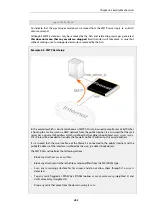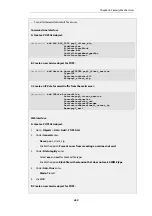
In both the cases of using
IP Rule
objects or
IP Policy
objects, the predefined
Service
object called
sip-udp
could be used. However, it is recommended to create a new
Service
object and the
examples in this section do this.
SIP ALG Options
The following options can be configured for a SIP ALG object:
•
Maximum Sessions per ID
The number of simultaneous sessions that a single client can be involved with is restricted by
this value. The default number is
5
.
•
Maximum Registration Time
The maximum time for registration with a SIP Registrar. The default value is
3600
seconds.
•
SIP Signal Timeout
The maximum time allowed for SIP sessions. The default value is
43200 seconds
.
•
Data Channel Timeout
The maximum time allowed for periods with no traffic in a SIP session. A timeout condition
occurs if this value is exceeded. The default value is
120 seconds
.
•
Allow TCP data channels
TCP data channels can be used during a SIP session.
•
Maximum number of TCP channels per call
If
Allow TCP data channels
is enabled this option is available to specify the maximum time
number of TCP channels allowed in a SIP session.
•
Allow clients to exchange media directly when possible
If this option is enabled then data, such as RTP/RTCP communication, may take place directly
between two clients without involving the NetDefend Firewall. This would only happen if the
two clients were behind the same interface and belong to the same network. The default
value is
Disabled
.
The SIP Proxy Record-Route Option
To understand how to set up SIP scenarios with NetDefendOS, it is important to first understand
the SIP proxy
Record-Route
option. SIP proxies have the Record-Route option either enabled or
disabled. When it is switched on, a proxy is known as a
Stateful proxy
. When Record-Route is
enabled, a proxy is saying it will be the intermediary for all SIP signaling that takes place between
two clients.
When a SIP session is being set up, the calling client sends an
INVITE
message to its outbound SIP
proxy server. The SIP proxy relays this message to the remote proxy server responsible for the
called, remote client's contact information. The remote proxy then relays the
INVITE
message to
the called client. Once the two clients have learnt of each other's IP addresses, they can
communicate directly with each other and remaining SIP messages can bypass the proxies. This
facilitates scaling since proxies are used only for the initial SIP message exchange.
The disadvantage of removing proxies from the session is that NetDefendOS IP rules (or IP
policies) must be set up to allow all SIP messages through the NetDefend Firewall, and if the
Chapter 6: Security Mechanisms
466
Summary of Contents for NetDefendOS
Page 30: ...Figure 1 3 Packet Flow Schematic Part III Chapter 1 NetDefendOS Overview 30 ...
Page 32: ...Chapter 1 NetDefendOS Overview 32 ...
Page 144: ...Chapter 2 Management and Maintenance 144 ...
Page 284: ...Chapter 3 Fundamentals 284 ...
Page 392: ...Chapter 4 Routing 392 ...
Page 419: ... Host 2001 DB8 1 MAC 00 90 12 13 14 15 5 Click OK Chapter 5 DHCP Services 419 ...
Page 420: ...Chapter 5 DHCP Services 420 ...
Page 573: ...Chapter 6 Security Mechanisms 573 ...
Page 607: ...Chapter 7 Address Translation 607 ...
Page 666: ...Chapter 8 User Authentication 666 ...
Page 775: ...Chapter 9 VPN 775 ...
Page 819: ...Chapter 10 Traffic Management 819 ...
Page 842: ...Chapter 11 High Availability 842 ...
Page 866: ...Default Enabled Chapter 13 Advanced Settings 866 ...
Page 879: ...Chapter 13 Advanced Settings 879 ...







































